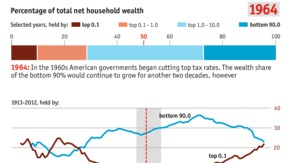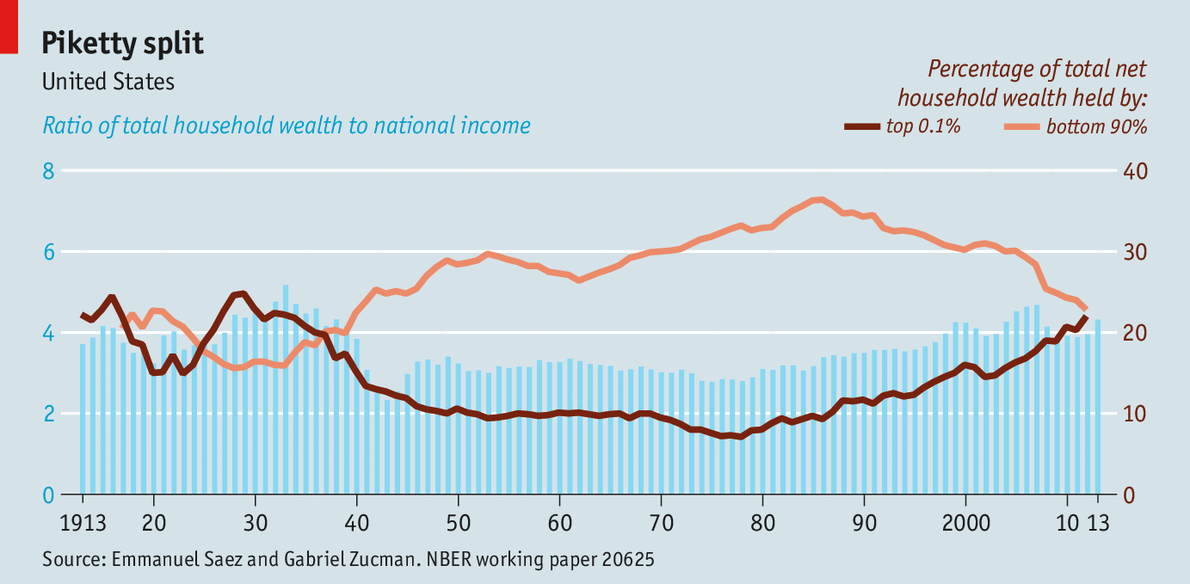AMONG the most controversial of Thomas Piketty’s arguments in his
bestselling analysis of inequality, “Capital in the Twenty-First
Century”, is that wealth is increasingly concentrated in the hands of
the very rich. Rising wealth inequality could presage the return of an
18th century inheritance society, in which marrying an heir is a surer
route to riches than starting a company. Critics question the premise:
Chris Giles, the economics editor of the
Financial Times,
argued earlier this year that Mr Piketty’s data were both thin and
faulty. Yet a new paper suggests that, in America at least, inequality
in wealth is approaching record levels.*
Earlier studies of American wealth have tended to show only small
increases in inequality in recent decades. A 2004 study of estate-tax
data by Wojciech Kopczuk of Columbia University and Emmanuel Saez of the
University of California, Berkeley, found an almost imperceptible rise
in the share of wealth held by the top 1% of families, from about 19% in
1976 to 21% in 2000. A more recent investigation of the Federal
Reserve’s data on consumer finances, by Edward Wolff of New York
University showed a continued but gentle increase in inequality into the
2000s. Mr Piketty’s book, which drew on this previous work, showed
similarly modest rises in wealth inequality in America.
A new paper by Mr Saez and Gabriel Zucman of the London School of
Economics reckons past estimates badly underestimated the share of
wealth belonging to the very rich. It uses a richer variety of sources
than prior studies, including detailed data on personal income taxes
(which the authors mine for figures on capital income) and property tax,
which they check against Fed data on aggregate wealth. The authors note
that not every potential source of error can be accounted for; tax
avoidance strategies, for instance, could cause either an overestimation
of the wealth share of the rich (if they classify labour income as
capital income in order to take advantage of lower rates) or an
underestimation (if they intentionally seek out lower yielding
investments for their tax advantages). Yet they believe their estimates
represent an improvement over past attempts.
The results are enough to make Mr Piketty blush. The authors examine
the share of total wealth held by the bottom 90% of families relative to
those at the very top. Because the bottom half of all families almost
always has no net wealth, the share of wealth held by the bottom 90% is
an effective measure of “middle class” wealth, or that held by those
from the 50th to the 90th percentile. In the late 1920s the bottom 90%
held just 16% of America’s wealth—considerably less than that held by
the top 0.1%, which controlled a quarter of total wealth just before the
crash of 1929. From the beginning of the Depression until the end of
the second world war, the middle class’s share of total wealth rose
steadily, thanks largely to collapsing wealth among richer households.
Thereafter the middle class’s share grew along with national wealth
thanks to broader equity ownership, middle-class income growth and
rising rates of home-ownership. The expansion of tax breaks for
retirement savings also helped. By the early 1980s the share of
household wealth held by the middle class rose to 36%—roughly four times
the share controlled by the top 0.1%.

Track wealth distribution decade-by-decade with our interactive inequality "swing-o-meter"
From the early 1980s, however, these trends have reversed. The ratio
of household wealth to national income has risen back toward the level
of the 1920s, but the share in the hands of middle-class families has
tumbled (see chart). Tepid growth in middle-class incomes is partly to
blame; real incomes for the top 1% of families grew 3.4% a year from
1986-2012 while those for the bottom 90% grew 0.7%. But Messrs Saez and
Zucman reckon the main cause of falling middle-class net worth is
soaring debt. Rising home values did little to raise middle-class wealth
since mortgage debt also soared. The recession battered home prices but
left the debt untouched, further squeezing middle-class wealth.
The really, really rich get much, much richer
On the other side of the spectrum, the fortunes of the wealthy have
grown, especially at the very top. The 16,000 families making up the
richest 0.01%, with an average net worth of $371m, now control 11.2% of
total wealth—back to the 1916 share, which is the highest on record.
Those down the distribution have not done quite so well: the top 0.1%
(consisting of 160,000 families worth $73m on average) hold 22% of
America’s wealth, just shy of the 1929 peak—and exactly the same share
as the bottom 90% of the population. Meanwhile the share of wealth held
by families from the 90th to the 99th percentile has actually fallen
over the last decade, though not by as much as the net worth of the
bottom 90%.
The outsize fortunes of the few would not be too worrying were they
largely the product of entrepreneurial activity: riches amassed by
hardworking billionaires who are as likely as not to give their bounty
away through philanthropy. Messrs Saez and Zucman find some evidence for
this dynamic. Wealthy families are younger than they were a generation
or two ago, and they earn a larger share of the country’s income from
labour: 3.1% in 2012 versus less than 0.5% prior to 1970.
Yet one should not yet rule out the return of Mr Piketty’s
“patrimonial capitalism”. The club of young rich includes not only Mark
Zuckerbergs, the authors argue, but also Paris Hiltons: young heirs to
previously accumulated fortunes. What’s more, the share of labour income
earned by the top 0.1% appears to have peaked in 2000. In recent years
the proportion of the wealth of the very rich held in the form of shares
has levelled off, while that held in bonds has risen. Since the
fortunes of most entrepreneurs are tied up in the stock of the firms
that they found, these shifts hint that America’s biggest fortunes may
be starting to have less to do with building businesses, just as Mr
Piketty warned.
*Studies cited in this article
"Top wealth shares in the United States, 1916-2000: Evidence from estate tax returns", by Wojciech Kopczuk and Emmanuel Saez, National Tax Journal, June 2004.
"Recent trends in household wealth in the United States: Rising debt and the middle-class squeeze—an update to 2007", by Edward Wolff, Levy Economics Institute Working Paper, March 2010.
"Wealth inequality in the United States since 1913: Evidence from capitalized income tax data", by Emmanuel Saez and Gabriel Zucman, National Bureau of Economics Research Working Paper, October 2014.




No comments:
Post a Comment